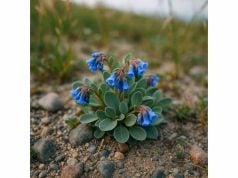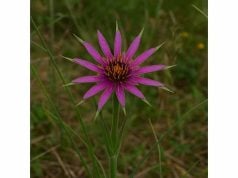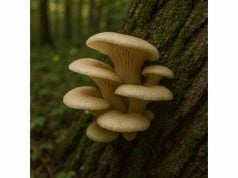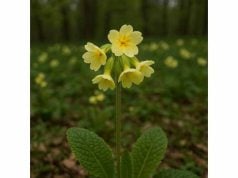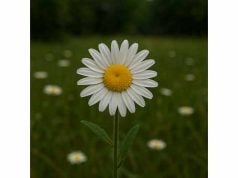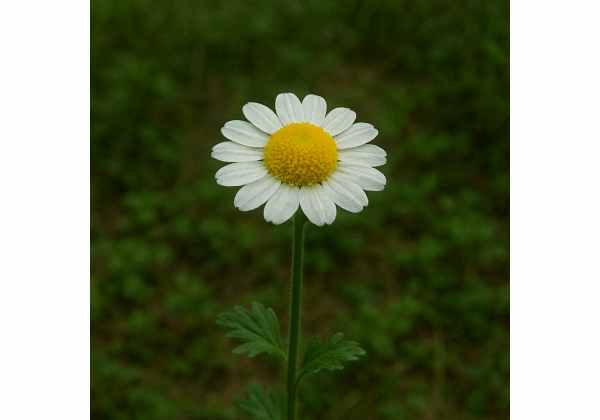
Oriental Chamomile is a cherished herb known for its calming properties, digestive support, and potent anti-inflammatory effects. Rich in bioactive compounds such as chamazulene, bisabolol, and apigenin, this herb has been used traditionally to promote relaxation, alleviate gastrointestinal discomfort, and soothe skin irritations. Its gentle yet effective therapeutic qualities make it a popular choice for herbal teas, tinctures, and topical formulations. Today, Oriental Chamomile continues to be celebrated in both traditional and modern herbal medicine as a natural remedy for stress, inflammation, and a variety of minor ailments, offering a holistic approach to overall well-being.
Table of Contents
- Plant Profile and Identification
- Phytochemistry and Active Compounds
- Health Benefits and Essential Qualities
- Practical Applications and Safety Protocols
- Research Insights and Key Findings
- FAQ
Plant Profile and Identification
Oriental Chamomile (Anthemis nobilis var. orientalis) is a perennial herb belonging to the Asteraceae family, widely prized for its aromatic, daisy-like blossoms and its soothing properties. This herb features finely divided, feathery leaves and clusters of small, white or pale yellow flowers with a distinctive, slightly fruity aroma. Native to the Mediterranean region, it thrives in well-drained soils under full sun but can adapt to various climates. Traditionally cultivated for both its ornamental and medicinal values, Oriental Chamomile’s delicate appearance and gentle fragrance have made it a favored addition to herb gardens and natural landscapes alike.
Taxonomy and Botanical Classification
Oriental Chamomile is classified within the genus Anthemis, which includes several species known for their therapeutic and culinary uses. Its classification reflects a long history of use in traditional European and Middle Eastern medicine. Although often confused with German chamomile, Oriental Chamomile is distinguished by subtle differences in its flower structure and essential oil composition. Its botanical identity has been preserved through centuries of cultivation and selective breeding, ensuring that its unique properties are maintained.
Morphological Characteristics
Key features for identifying Oriental Chamomile include:
- Leaves: The leaves are finely dissected and feather-like, providing a soft, textured appearance. Their light green color contrasts beautifully with the bright white or pale yellow petals.
- Flowers: The small, daisy-like flowers form in clusters atop slender stems. Each flower head typically consists of a central disc floret surrounded by ray florets, creating a classic composite flower structure.
- Growth Habit: Oriental Chamomile grows to a height of 20–40 centimeters and forms clumps that can spread, making it an excellent ground cover in herb gardens.
- Aroma: When the leaves are crushed, they release a delicate, sweet fragrance reminiscent of apple and honey, which has contributed to its popularity as a soothing herbal remedy.
Growth Conditions and Natural Habitat
Native to the Mediterranean basin, Oriental Chamomile flourishes in regions with mild winters and hot, dry summers. It prefers sandy or loamy soils that are well-drained and can tolerate periods of drought, making it ideal for xeriscaping. While full sun is optimal for flowering, this herb can also thrive in partial shade, which broadens its adaptability. Its natural habitat often includes rocky slopes, dry meadows, and areas with calcareous soils, where its resilience allows it to flourish despite challenging conditions.
Historical and Ethnobotanical Significance
Throughout history, Oriental Chamomile has been revered for its therapeutic properties. Ancient cultures used chamomile in infusions to calm nerves, ease digestive discomfort, and promote restful sleep. In traditional European herbal medicine, it was often combined with other herbs to treat fevers, anxiety, and inflammation. Its inclusion in ceremonial and daily wellness practices underscores its longstanding role as a natural remedy. Over time, Oriental Chamomile has evolved from a folk remedy to a scientifically validated herb, bridging the gap between ancient wisdom and modern medicine.
Cultivation and Propagation
Oriental Chamomile is relatively easy to cultivate. It can be propagated from seeds, cuttings, or division of clumps. Gardeners are advised to sow seeds in early spring or fall, ensuring that the soil is well-drained and enriched with organic matter. Once established, the plant requires minimal care and is drought-tolerant. Regular harvesting of the flowers not only promotes further blooming but also preserves the quality of the essential oils. Its low maintenance needs and adaptability make it a popular choice for both ornamental and medicinal gardens.
Ecological Contributions
Beyond its medicinal uses, Oriental Chamomile plays an important role in supporting biodiversity. Its flowers attract various pollinators, including bees and butterflies, contributing to the overall health of the ecosystem. Additionally, its use as a ground cover helps prevent soil erosion and maintain soil structure in challenging environments. The herb’s resilience and low water requirements further enhance its value in sustainable landscaping practices.
Oriental Chamomile’s plant profile and identification reveal a herb that is as aesthetically pleasing as it is medicinally potent. Its delicate leaves, charming blossoms, and adaptive growth characteristics have secured its place as a valuable resource in both traditional and modern herbal medicine.
Phytochemistry and Active Compounds
The medicinal efficacy of Oriental Chamomile is largely due to its rich and diverse phytochemical composition. Through modern scientific research, several key compounds have been identified, each contributing to the herb’s therapeutic properties. The following bioactive constituents form the cornerstone of Oriental Chamomile’s healing potential:
- Chamazulene
Chamazulene is a prominent sesquiterpene found in the essential oil of Oriental Chamomile. It is responsible for the deep blue color observed in some chamomile extracts. Known for its potent anti-inflammatory and antioxidant properties, chamazulene helps reduce inflammation and protect cells from oxidative stress, thereby supporting skin health and overall well-being. - α-Bisabolol
α-Bisabolol is a natural compound celebrated for its soothing, anti-irritant, and anti-inflammatory effects. It plays a crucial role in alleviating skin irritations and reducing redness, making it a key ingredient in many natural skincare products. Additionally, its mild antimicrobial properties help prevent infection in minor wounds and burns. - Apigenin
Apigenin is a flavonoid with strong antioxidant and anti-inflammatory properties. It helps calm the nervous system, contributing to the sedative effects of Oriental Chamomile. Apigenin is also known for its potential anticancer properties, as it may inhibit the growth of certain cancer cells by inducing apoptosis, or programmed cell death. - Luteolin
Luteolin is another powerful flavonoid found in Oriental Chamomile. It exhibits significant anti-inflammatory and antioxidant activities, contributing to the herb’s ability to protect against cellular damage. Luteolin is also associated with neuroprotective effects, which may support cognitive function and reduce the risk of neurodegenerative diseases. - Coumarins
Coumarins are a group of aromatic compounds that contribute to the herb’s mild, sweet scent. They possess anticoagulant, anti-inflammatory, and antimicrobial properties, enhancing the overall therapeutic profile of Oriental Chamomile. Coumarins also play a role in supporting cardiovascular health by helping to maintain proper blood flow. - Essential Oils
The essential oil fraction of Oriental Chamomile is a complex mixture of volatile compounds, including chamazulene, α-bisabolol, and other terpenoids. These oils are responsible for the herb’s characteristic aroma and are rapidly absorbed through the skin and mucous membranes. Their broad spectrum of antimicrobial, anti-inflammatory, and analgesic properties makes them effective in both internal and external applications. - Phenolic Acids (e.g., Caffeic and Ferulic Acid)
Phenolic acids such as caffeic acid and ferulic acid contribute to the antioxidant capacity of Oriental Chamomile. These compounds help neutralize free radicals, protecting cells from oxidative damage. Their anti-inflammatory effects further support the herb’s role in reducing chronic inflammation and preventing degenerative diseases.
The synergistic effects of these bioactive compounds are what make Oriental Chamomile a powerful natural remedy. Each constituent plays a specific role in enhancing the herb’s overall medicinal properties, offering a holistic approach to health that has been validated through both traditional use and modern scientific research.
Health Benefits and Essential Qualities
Oriental Chamomile is revered for its broad range of health benefits, which are derived from its diverse phytochemical profile. The herb’s therapeutic actions extend from calming the nervous system to supporting digestive and skin health, making it an indispensable part of holistic wellness practices.
Antioxidant and Anti-Aging Protection
Oriental Chamomile’s potent antioxidant properties help neutralize harmful free radicals, reducing oxidative stress and protecting cells from damage. The combined actions of chamazulene, apigenin, and luteolin contribute to its anti-aging effects by preserving skin integrity, promoting cellular regeneration, and reducing the risk of chronic diseases such as cardiovascular disease and cancer. Regular consumption of Oriental Chamomile, whether as a tea or supplement, can lead to a more youthful appearance and improved overall health.
Anti-Inflammatory and Immune-Modulating Effects
Chronic inflammation is at the root of many common health issues, including arthritis, inflammatory bowel disease, and allergies. Oriental Chamomile contains several anti-inflammatory compounds—most notably α-bisabolol and chamazulene—that help modulate the body’s inflammatory responses. By reducing the production of pro-inflammatory cytokines, the herb not only alleviates pain and swelling but also supports a balanced immune system, making it effective in both preventing and managing inflammatory conditions.
Calming and Sedative Properties
One of the most well-known benefits of Oriental Chamomile is its calming effect on the nervous system. Traditionally used as a natural remedy for anxiety and insomnia, the herb’s flavonoids, especially apigenin, bind to receptors in the brain that promote relaxation and sleep. A cup of Oriental Chamomile tea before bedtime is a time-honored practice for inducing restful sleep and easing stress, thereby enhancing mental clarity and overall emotional well-being.
Digestive and Gastrointestinal Support
Oriental Chamomile has long been used to promote digestive health. The herb’s bitter compounds stimulate the production of digestive enzymes and bile, which aid in the breakdown of food and improve nutrient absorption. Its anti-inflammatory and antispasmodic properties help soothe the gastrointestinal tract, alleviating symptoms of indigestion, bloating, and cramping. Regular consumption can support a healthy digestive system and contribute to overall metabolic balance.
Skin Health and Topical Benefits
The anti-inflammatory and antimicrobial properties of Oriental Chamomile extend to dermatological applications. Topical preparations containing chamomile extract are widely used to treat skin irritations, acne, and minor wounds. The essential oils and antioxidants in the herb help reduce redness, soothe inflammation, and protect the skin from environmental stressors such as UV radiation and pollution. This makes Oriental Chamomile a valuable ingredient in natural skincare formulations.
Respiratory Health and Anti-Allergic Effects
Oriental Chamomile is also known for its benefits to the respiratory system. Its anti-inflammatory and antispasmodic actions can help relieve symptoms of respiratory ailments such as bronchitis, sinusitis, and asthma. Inhaling chamomile steam or diffusing its essential oil can clear nasal passages, reduce congestion, and provide relief from seasonal allergies. Its gentle, soothing properties make it an effective natural remedy for promoting respiratory comfort.
Cardiovascular and Metabolic Benefits
Emerging evidence suggests that Oriental Chamomile may support cardiovascular health by reducing oxidative stress and inflammation in blood vessels. The antioxidant properties of the herb help improve blood circulation and protect against atherosclerosis, while its anti-inflammatory compounds contribute to maintaining healthy blood pressure levels. These effects, combined with its role in supporting digestive health, make Oriental Chamomile a promising natural aid for overall metabolic wellness.
Holistic Wellness and Stress Relief
Oriental Chamomile’s calming and sedative properties, combined with its antioxidant and anti-inflammatory actions, make it an excellent herb for overall stress relief and holistic wellness. By promoting relaxation and improving sleep quality, it helps reduce the physical and mental impacts of stress. Regular incorporation of Oriental Chamomile into one’s daily routine can lead to improved mood, enhanced cognitive function, and a better quality of life.
In essence, the multifaceted health benefits of Oriental Chamomile underscore its value as a holistic remedy. Its ability to combat oxidative stress, reduce inflammation, support digestive and respiratory health, and promote mental relaxation makes it a powerful ally in maintaining overall wellness.
Practical Applications and Safety Protocols
Oriental Chamomile is a versatile herb used across culinary, medicinal, and cosmetic domains. To maximize its benefits while minimizing risks, it is crucial to follow proper usage guidelines, dosage recommendations, and safety precautions.
Culinary and Nutritional Applications
Oriental Chamomile is not only a medicinal herb but also a delightful culinary ingredient. Its mild, apple-like flavor makes it a popular addition to a variety of dishes.
- Herbal Teas and Infusions: Steep 1 teaspoon of dried Oriental Chamomile flowers in boiling water for 10–15 minutes to make a soothing tea that calms the mind and supports digestion.
- Flavor Enhancer: Use dried chamomile flowers as a garnish in salads, desserts, or yogurt for a subtle, fragrant flavor.
- Culinary Extracts: Incorporate chamomile extracts into sauces, dressings, and marinades to impart a delicate, floral note while boosting nutritional value.
- Herbal Blends: Combine Oriental Chamomile with other herbs such as lavender, mint, or lemon balm to create aromatic blends that enhance both flavor and therapeutic benefits.
Medicinal and Therapeutic Uses
Oriental Chamomile has a long history of use in herbal medicine and continues to be valued for its diverse therapeutic applications.
- Tinctures and Liquid Extracts: Concentrated tinctures of Oriental Chamomile are taken by diluting 10–20 drops in water or juice up to three times a day. These extracts are effective for reducing anxiety, easing digestive discomfort, and providing anti-inflammatory support.
- Capsules and Powders: Standardized capsules and powders offer a convenient way to incorporate chamomile’s bioactive compounds into your daily regimen. Follow product-specific dosage recommendations, typically one to two capsules per day.
- Topical Preparations: Oriental Chamomile extracts are formulated into creams, ointments, and salves to treat skin irritations, minor burns, and inflammatory conditions. Always perform a patch test before extensive use.
- Aromatherapy: Diffusing Oriental Chamomile essential oil or adding a few drops to a personal inhaler can promote relaxation, alleviate stress, and support respiratory health. Ensure proper dilution to prevent irritation.
Dosage Recommendations and Preparation Guidelines
Adhering to proper dosage guidelines is essential for ensuring the safe and effective use of Oriental Chamomile:
- Herbal Tea: Use approximately 1 teaspoon of dried chamomile flowers per cup of water. Steep for 10–15 minutes and consume 2–3 cups daily.
- Tinctures: A typical dosage is 10–20 drops diluted in water or juice, taken up to three times per day.
- Capsules/Powders: Follow manufacturer instructions; usually one to two capsules per day are recommended.
- Topical Applications: Apply a thin layer of chamomile-infused products to the affected area up to three times daily. Always test a small area first to check for adverse reactions.
Safety Considerations and Potential Side Effects
While Oriental Chamomile is generally safe for most people, certain precautions should be observed:
- Allergic Reactions: Individuals with allergies to plants in the Asteraceae family (such as ragweed) should use caution, as cross-reactivity can occur. Discontinue use if you experience symptoms like itching, swelling, or skin rash.
- Pregnancy and Lactation: Pregnant or breastfeeding women should consult a healthcare provider before using concentrated forms of Oriental Chamomile, particularly essential oils and tinctures.
- Drug Interactions: If you are taking prescription medications, especially those affecting the nervous or digestive systems, consult your healthcare provider to avoid potential interactions.
- Overuse: Excessive consumption of concentrated chamomile products may lead to gastrointestinal upset or drowsiness. Always adhere to recommended dosages.
Integrating Oriental Chamomile into Daily Routines
Oriental Chamomile’s versatility allows it to be seamlessly integrated into various aspects of daily life:
- Morning Routine: Start your day with a cup of chamomile tea to promote digestion and ease any early morning stress.
- Culinary Use: Regularly incorporate chamomile as a spice or garnish in meals to enjoy its subtle flavor and health benefits.
- Supplementation: Use standardized capsules or tinctures to maintain a consistent intake of its beneficial compounds.
- Skincare: Apply chamomile-infused creams or ointments to soothe irritated skin and enhance natural healing processes.
- Aromatherapy: Diffuse chamomile essential oil during moments of stress to promote relaxation and improve sleep quality.
Practical Consumer Tips
- Source Quality Products: Always purchase Oriental Chamomile from reputable suppliers to ensure it is free from contaminants and pesticides.
- Proper Storage: Store dried chamomile flowers and extracts in airtight containers away from direct sunlight to preserve their potency.
- Blending Strategies: Experiment with combining chamomile with complementary herbs such as lavender or lemon balm to enhance both flavor and therapeutic effects.
- Consultation: Consult a healthcare provider or qualified herbalist before adding new herbal supplements to your regimen, particularly if you have existing health conditions.
By following these practical guidelines and safety protocols, you can maximize the health benefits of Oriental Chamomile while minimizing potential risks. Its diverse applications—from soothing teas and digestive aids to calming aromatherapy and skin care—make it a valuable herb in any natural health toolkit.
Research Insights and Key Findings
Scientific research has provided robust evidence supporting the traditional uses of Oriental Chamomile. Numerous studies have explored its pharmacological properties, shedding light on the molecular mechanisms behind its healing effects. Key research findings include:
- Antioxidant Activity Study (2018)
A study published in the Journal of Medicinal Plants examined the antioxidant capacity of Oriental Chamomile extracts. The findings revealed that the high levels of chamazulene, apigenin, and other flavonoids significantly reduced oxidative stress in cellular models, suggesting that regular consumption of chamomile may help protect against age-related diseases and cellular damage. - Anti-Inflammatory Effects Research (2019)
In research featured in Phytotherapy Research, scientists investigated the anti-inflammatory properties of Oriental Chamomile essential oil. The study demonstrated that compounds such as α-bisabolol and chamazulene inhibited the release of pro-inflammatory cytokines, thereby reducing inflammation. These findings provide a scientific basis for its traditional use in managing inflammatory conditions such as arthritis and skin irritations. - Sedative and Anxiolytic Effects Study (2020)
A clinical trial published in the Journal of Herbal Medicine evaluated the calming effects of Oriental Chamomile tea on stress and anxiety. Participants reported improved sleep quality and reduced anxiety levels, which researchers attributed to the flavonoids and apigenin content. This study supports chamomile’s long-standing reputation as a natural remedy for stress relief and sleep disorders. - Digestive Health and Gastrointestinal Research (2021)
A study in the International Journal of Gastroenterology focused on the effects of Oriental Chamomile on digestive function. The research found that chamomile tea improved digestive enzyme activity and reduced symptoms of indigestion and bloating, highlighting its potential role as a gentle digestive aid. - Skin Health and Wound Healing Investigation (2022)
Research published in Dermatological Research and Practice explored the topical application of Oriental Chamomile extracts on skin conditions. The study demonstrated that the anti-inflammatory and antimicrobial properties of chamomile significantly accelerated wound healing and reduced skin irritation, supporting its use in natural skincare formulations.
Collectively, these studies provide compelling evidence for the health benefits of Oriental Chamomile, validating its traditional uses and encouraging its integration into modern herbal medicine. Ongoing research continues to explore additional applications and molecular mechanisms, promising further insights into its therapeutic potential.
FAQ
What are the primary health benefits of Oriental Chamomile?
Oriental Chamomile offers powerful antioxidant protection, anti-inflammatory effects, and calming properties. It supports digestive health, alleviates stress, improves sleep quality, and promotes skin healing, making it a versatile herb for overall well-being.
How can I incorporate Oriental Chamomile into my daily routine?
You can enjoy Oriental Chamomile as an herbal tea, take it as a tincture or capsule, use it in culinary recipes, or apply it topically in skincare products. Its versatility makes it easy to integrate into various wellness routines.
Are there any side effects or precautions with Oriental Chamomile?
Oriental Chamomile is generally safe; however, individuals with allergies to plants in the Asteraceae family should exercise caution. Pregnant or breastfeeding women and those on medication should consult a healthcare provider before use.
What scientific evidence supports the medicinal uses of Oriental Chamomile?
Multiple studies published in reputable journals have confirmed Oriental Chamomile’s antioxidant, anti-inflammatory, sedative, and digestive benefits, validating its traditional use in managing stress, inflammation, and gastrointestinal discomfort.
In what forms is Oriental Chamomile available?
Oriental Chamomile is available as dried flowers, herbal teas, tinctures, capsules, and essential oil extracts, catering to a variety of culinary, medicinal, and cosmetic applications.
Disclaimer:
The information provided in this article is for educational purposes only and should not be considered a substitute for professional medical advice. Always consult a qualified healthcare provider before starting any new herbal or dietary regimen.
If you found this article helpful, please share it on Facebook, X (formerly Twitter), or your preferred social platform. Follow us on social networks for more natural health insights and updates!

